
Feature Article
Practical Tips for Food Storage with Refrigerators and Freezers
Refrigerators and freezers are indispensable equipment for food storage. Proper food storage is essential to ensuring food safety as well as quality. This article will discuss the pros and cons of refrigeration and freezing, explain what kinds of food should be stored in the fridge and their storage periods, and the proper practices to keep food safe in the fridge.
Refrigeration versus Freezing – Are They the Same?
While both refrigeration and freezing can preserve food by keeping it at low temperatures and out of the temperature danger zoneNote 1, the conditions under which food is preserved are not identical. Refrigerated foods are kept at 4°C or below, under which the growth of many types of bacteria is inhibited. Most foods can maintain their textures upon storage under refrigeration. However, some types of bacteria, like Listeria monocytogenes, can still thrive at refrigerated temperatures. It is worth noting that Listeria monocytogenes, if present, can proliferate in the refrigerator over time and lead to foodborne illnesses.
In contrast, bacteria are forced into a dormant stage when foods are stored at –18°C or below. When compared with refrigeration, food spoilage is minimised because micro-biological development is inhibited. Besides, freezing food like fish at –20°C or below for seven days or at –35°C or below for about 20 hours can kill parasites in food manufacturing processes. However, some food may have quality issues upon freezing, which include freezer burnNote 2 in frozen meats, fat bloom (whitish or greyish coating) on chocolates and unstable oil-in-water emulsions (discrete aqueous and oil layers) in mayonnaise, making them unsuitable for food preparation. Prior to freezing or refrigerating food, it is advisable to prepare ahead and check which items can be kept fresh and nutritious.
Types and Storage Periods of Food in the Fridge
Refrigeration and freezing are widely adopted in storing perishable foods including meats, seafood and processed foods like sausages. Nevertheless, not all food items are suitable to be kept in the fridge. Fruit and vegetables like bananas may be susceptible to chilling injury (damage or deterioration which occurs when food is exposed to temperatures below its optimal storage temperature). Chilling injury is a phenomenon that can reduce the quality of food and
shorten its shelf life. Besides, shell eggs should not be put into freezers. Freezing shell eggs may alter their protein structure and cause the shells to crack. Eggs should be stored in the refrigerator rather than frozen.
Some may think that refrigerated and frozen foods have significantly longer shelf lives, but it should be noted that storage periods vary with the types of food. Refrigerated foods can still be spoiled after prolonged storage, while foods like fresh poultry can be kept for days for safe consumption. Of note, once the packaging of prepackaged food is opened, the date mark will become irrelevant. Follow the manufacturer’s instructions on the storage period and conditions after opening.
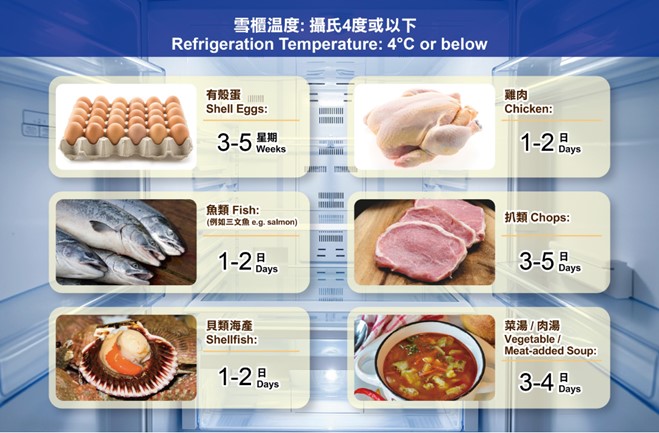
Figure 1: Storage periods of some refrigerated foods
(Source: Food and Drug Administration https://www.fda.gov/media/74435/download)
Separate Raw and Cooked Foods Properly and Keep Fridges Clean
Separating raw foods from ready-to-eat (RTE) and cooked foods is essential to preventing cross-contamination. Foods should be stored in covered or sealed containers before they are put into the fridge or freezer. Raw foods should be stored below cooked or RTE foods to prevent their juices from dripping onto the cooked or RTE foods, leading to cross-contamination. For large scale food storage, it is preferable to have different cold storage equipment for separating raw foods from RTE and cooked foods. Besides, fridges should be cleaned regularly.
Key Points to Note:
- Refrigeration and freezing preserve foods by keeping them at low temperatures but under different conditions.
- While refrigeration and freezing can be used to store a wide range of foods and extend their shelf lives, these methods may not be suitable for preserving some food items.
- When refrigerating or freezing foods, raw foods should be separated from RTE and cooked foods.
- Clean the fridge and freezer compartments regularly.
Advice to the Consumers:
- Keep appliance thermometers inside refrigerators and freezers without temperature monitoring devices and check the readings regularly.
- Follow the 2-hour / 4-hour rule for storing RTE and cooked foods in the fridge.
- Always keep fridge doors closed.
Note 1 To learn more about the temperature danger zone, please visit the following webpage or scan the relevant QR code.
https://www.cfs.gov.hk/english/trade_zone/safe_kitchen/Temperature_Danger_Zone.html

Note 2 For more information about “freezer burn”, please visit the following webpage or scan the relevant QR code.
https://www.cfs.gov.hk/english/multimedia/multimedia_pub/multimedia_pub_fsf_190_02.html

Mascot ON in Lesson
1.Plant-Based Meat - What are they and How do they Compare with Meat?
In the quest for sustainable eating habits, plant-based meat (PBM) has emerged as a popular alternative to conventional animal meat. Known also as meat substitutes or analogs, PBM products are manufactured to replicate the taste, texture and appearance of meat using plant-derived ingredients.
What is PBM?
Historically, Asian cuisines have utilised soy products to create vegetarian dishes akin to meat flavours. Examples include vegetarian chicken made from bean curd sheets and vegetarian lo mei produced from wheat gluten. Modern PBMs often comprise proteins from soy, wheat, peas and mushrooms, which provide the necessary texture and structure resembling meat. To enhance the sensory experience, ingredients like coconut oil are added for juiciness, while binders like methylcellulose ensure cohesion. Various seasonings are also added to enrich the flavour profile, mimicking the sensory experience of consuming conventional meat.

Figure 2: Production of PBM
Nutritional Composition and Comparison with Conventional Meat
While PBMs are noted for their environmental sustainability over meat, it is crucial to examine their nutritional profile compared with that of conventional meat. PBMs’ low cholesterol levels and often higher dietary fibre content are two of their main benefits. However, unlike meat, which is a complete protein source containing all essential amino acids, PBMs require careful combination with other proteins or the consumer has to take supplements to achieve a similar nutritional intake.
A study by researchers at the Chinese University of Hong Kong in 2023 revealed that over 270 prepackaged PBM products from 27 brands were available locally, with a significant percentage containing medium to high levels of fat, salt and sugar based on the information on the nutrition labels. These findings suggest that while PBMs can mimic the texture and taste of meat, they can also inherit some of the unhealthy attributes of processed foods. The World Health Organization (WHO) - Regional Office for Europe (WHO-Europe) has also highlighted that plant-based meals, especially those prepared outside the home, can contain a lot of salt. This indicates a gap in knowledge regarding the full nutritional composition of PBMs and how they contribute to a balanced diet as a whole.
The Importance of a Balanced Diet in Plant-Based Eating
A plant-based diet does not always equate to better health unless it is well-planned and balanced. PBMs may be deficient in some nutrients, such as vitamins B₁₂ and D, calcium, iron and certain essential amino acids, which highlights the need for careful dietary planning. WHO-Europe recommends opting for minimally processed plant foods to maximise health benefits. Consumers choosing PBMs should therefore be vigilant about the products’ nutritional content, which can vary widely between brands and types. It is always a good idea to read nutrition labels on prepackaged food and consider supplementing the diet with fortified foods or diverse plant sources to ensure the intake of all essential nutrients. Populations who have special nutrition needs and opt for vegetarian diets Note 1, including children, adolescents Note 2, pregnant women, lactating mothers, elderly persons and people with chronic diseases, should consult medical practitioners and dietitians in order to meet their special nutritional needs. Moreover, allergens that are usually not present in meat may be present in PBMs. People with food allergy should also look out for ingredients that they are allergic to, for example, soya, cereals grains (gluten) and nuts.
In conclusion, while PBMs offer a viable alternative for those seeking to reduce their meat consumption for ethical or environmental reasons, they should not be viewed as a direct nutritional substitute for animal meats. As an alternative, they ought to be incorporated into a diet consisting of a range of unprocessed plant foods and supplements may be needed to avoid any nutrient deficit. By making informed decisions and planning a diet that fulfills all nutritional requirements, people can enjoy the health benefits of a plant-based diet without compromising on nutritional quality.
Note 1: To learn more about “Guidelines for a Balanced Vegetarian Diet”, please visit the following webpage or scan the relevant QR code.
https://www.chp.gov.hk/en/static/90050.html

Note 2: For more information on “Vegetarian Diet and Nutrition”, please visit the following webpage or scan the relevant QR code.
https://www.studenthealth.gov.hk/english/health/health_dn/health_dn_vdn.html
2.Sweeteners: Myths and Facts
Sweeteners have been used for decades to help reduce sugar intake. Even though you may not add sweeteners in your diet, sweeteners are often used as ingredients in various food products, especially soft drinks and candies. Despite sweeteners’ long history of safe usage, there have been concerns about their potential health risks. In this article, we are dispelling some of the fallacies about sweeteners.
What are Sweeteners?
Sweeteners are food additives used instead of sugars to sweeten foods/beverages. Non-nutritive sweeteners, e.g. aspartame and saccharin, are substantially sweeter (30 to 20 000 times sweeter) than table sugar, thus only smaller amounts can achieve the same level of sweetness as sugars in food. Since only tiny amounts of non-nutritive sweeteners are required, their caloric contribution is negligible.
Another type of sweeteners is sugar alcohols (also known as polyols or polyhydric alcohols), e.g. sorbitol and xylitol, which are carbohydrates naturally found in small amounts in fruits and vegetables and can also be produced commercially. Unlike non-nutritive sweeteners, sugar alcohols are generally not as sweet as table sugar, with their sweetness ranging from 25% of 100% of that of table sugar. Since they are incompletely absorbed after ingestion, they contribute less calories as compared with sugars.
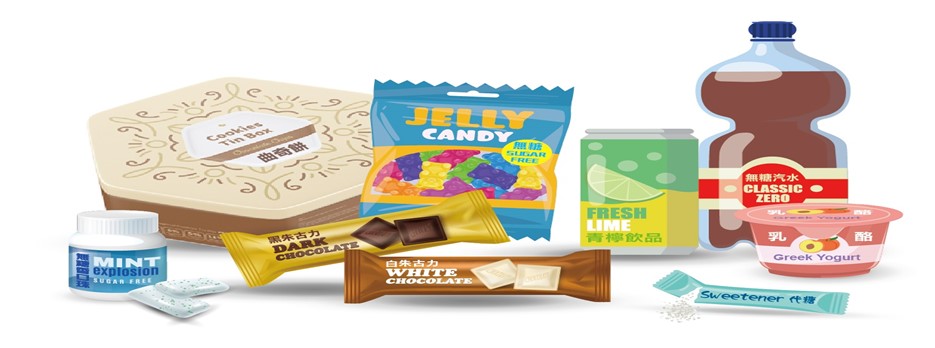
Figure 3: Common food products with sweeteners on the market
Truth about Sweeteners
Are all sweeteners artificial?
The basic requirement, as stipulated in Section 54 of the Public Health and Municipal Services Ordinance (Cap. 132), is that no food intended for sale should be unfit for human consumption. Imported pork in Hong Kong is regulated by the Imported Game, Meat, Poultry and Eggs Regulations (IGMPER), Cap. 132AK. Specifically, Regulation 4(1)(a) of Cap. 132AK requires meat, poultry or eggs to be imported with a health certificate issued by an issuing entity recognised by the Director of Food and Environmental Hygiene.
Are sweeteners safe?
Like other food additives, sweeteners have undergone rigorous safety evaluation before being permitted for food use. International and national food safety authorities, such as the Joint Food and Agriculture Organization of the United Nations/WHO Expert Committee on Food Additives (JECFA), evaluate the safety of sweeteners based on scientific reviews of all available toxicological and related data.
Concerns about sweeteners and cancer initially arose when early animal studies linked certain sweeteners (i.e. cyclamate and saccharin) with bladder cancer in laboratory animals. However, subsequent studies of the permitted sweeteners showed no evidence that sweeteners would cause cancer in humans. The International Agency for Research on Cancer (IARC) classified cyclamate and saccharin as “not classifiable as to their carcinogenicity to humans (Group 3)”.
Recently, IARC in 2023 classified aspartame as “possibly carcinogenic to humans (Group 2B)” based on limited evidence for carcinogenicity in humans. Nonetheless, JECFA, based on the evidence from animal and human studies, considered that aspartame had not been found to have adverse effects after ingestion, and that the evidence of an association between aspartame consumption and cancer in humans was not convincing. JECFA concluded that dietary exposure to aspartame within the previously established Acceptable Daily Intake of 0-40 mg/kg body weight did not pose a health concern.
Can sweeteners be used for weight control?
While sweeteners are safe for consumption, WHO released in 2023 a guideline which recommended against the use of non-sugar sweeteners (NSS) to control body weight. The recommendation was based on the findings of a systematic review of the available evidence which suggested that the use of NSS did not bring any long-term benefit in reducing body fat in adults/children. However, WHO pointed out that the evidence might have been confounded by the baseline characteristics of study participants and the complicated patterns of NSS use. WHO also remarked that the guideline did not apply to sugar alcohols or individuals with existing diabetes.
WHO advised that the key to weight control is to achieve an energy balance between calories consumed and burnt. People need to consider other ways to reduce free sugars intake, such as consuming food with naturally occurring sugars, like fruit, or unsweetened food and beverages. To improve health, people should reduce the sweetness of the diet altogether, starting early in life.
How are Sweeteners Regulated?
In Hong Kong, sweeteners are regulated under the Sweeteners in Food Regulations (Cap. 132U). At present, a total of ten permitted sweeteners are listed under Cap. 132U. To align with the latest international developments on the regulation of sweeteners in food, the Centre for Food Safety (CFS) has commenced the work to review the regulatory control of sweeteners. Sweeteners should be used under the condition of Good Manufacturing Practice with the quantity added to food limited to the lowest possible level necessary to accomplish the desired effect. Moreover, all prepackaged foods added with sweeteners are required to be properly labelled with their functional classes and specific names or identification numbers.
Advice to the Public:
- Maintain a balanced diet and select foods/beverages with less or no sugar/sweetener added.
- Read food labels to make informed choices.
Dining Out
1.Siu Mei Spy

When it comes to quick, delicious and satisfying food for your one-hour lunch break, siu mei definitely earn a spot on the list. However, even thoroughly cooked, siu mei can still be contaminated with bacteria if it is displayed, cut or stored improperly.
There have been cases of food poisoning caused by the consumption of siu mei contaminated with Salmonella and Staphylococcus aureus.
https://www.cfs.gov.hk/english/multimedia/multimedia_pub/multimedia_pub_fsf_206_01.html

S.aureus are commonly found on the hair, skin, nasal cavity, throat and wounds of humans. When a food handler whose hands are contaminated with this bacterium handles (e.g. by cutting) siu mei, the siu mei will be contaminated. Moreover, S. aureus will grow exponentially and form heat-stable toxins if siu mei is stored at room temperature for extended period. Even if you reheat the siu mei afterwards, it won't help.
Therefore, next time when you buy siu mei, bear in mind the following:
- Patronise well-maintained licensed premises;
- Pay attention to the food handlers’ personal hygiene, e.g. wearing a face mask and clean overalls, and wearing their gloves properly;
- Check whether siu mei is displayed in an insect and dust proof showcase;
- When putting siu mei in your shopping cart or bags, keep it separate from raw food (especially raw meat and seafood);
- Consume the siu mei you bought as soon as possible.
What else should you watch out for? Check it out here:
https://www.cfs.gov.hk/english/programme/programme_rafs/programme_rafs_fm_01_27.html

2.Listeria Monocytogenes in Meat and Poultry Products
Recent news reported that about 10 million pounds of ready-to-eat (RTE) meat and poultry products were recalled in the United States due to possible Listeria monocytogenes contamination. Samples were tested positive for Listeria monocytogenes in routine product testing by the regulatory authority. The products recalled include prepackaged sandwiches, salads and pastas.
Listeria monocytogenes is a pathogen widely dispersed in the environment and food. RTE foods with longer shelf lives under refrigeration, such as RTE meat or poultry, are at higher risk, as Listeria monocytogenes may proliferate in these contaminated foods at refrigeration temperatures if given sufficient time. The bacteria can be killed by cooking. Listeria monocytogenes infection can cause listeriosis, with symptoms including fever, vomiting and diarrhoea. In pregnant women, the infection can result in miscarriages and stillbirths. Serious or fatal infections can occur in the elderly and individuals with weakened immunity.
The public should check if food packages are intact. Chilled food should be cooked or reheated thoroughly before consumption. The trade should maintain good hygiene and food handling practices during food manufacturing processes.
Healthy Eating Basics and Smart Food Choices
Healthy Eating Basics
1. Role of Potassium Salt as a Substitute for Table Salt
Excessive intake of sodium, which might be due to the consumption of table salt, condiments or processed food, is associated with hypertension, heart disease and stroke. Locally, the major sourceNote 1 of sodium intake is the consumption of condiments and sauces, soup, etc. WHO recommends a daily intake of less than 5g of salt (or 2g sodium) from food to reduce blood pressure.
To reduce sodium intake, consumers can use nutrition labels to identify food with a lower sodium level. Manufacturers should reduce the level of sodium in their products. One of the options is to partially substitute table salt (sodium chloride, NaCl) with potassium chloride (KCl). However, individuals with certain medical conditions, like kidney disease, should seek medical advice before using KCl. Food products with added KCl should be labelled accordingly.
Be a smarter consumer, before buying pre-packaged food, read the nutrition labels carefully, compare the calorie, fat and sugar content of different products and opt for the ones with lower content. Also, eat in moderation!
Note 1: Information on “Reduce Salt/Sodium Intake to Prevent High Blood Pressure” is available at:
https://www.cfs.gov.hk/english/multimedia/multimedia_pub/multimedia_pub_fsf_81_01.html

Smart Food Choices
Pumpkin and Tomato Soup with Red Lentils
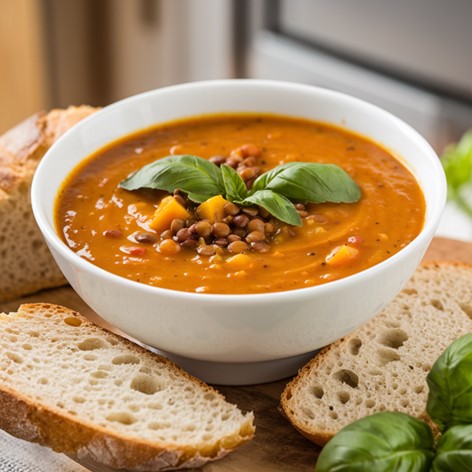
Pumpkin and tomato soup with red lentils is a nutritious dish. Pumpkins, packed with beta-carotene, have antioxidant properties; tomatoes, rich in vitamin C, can boost our immunity; while red lentils can fortify the spleen and dispel dampness in our body. This soup is not only tasty, but also helps stabilise blood pressure, making it an excellent choice for summer heat relief.
Ingredients (to serve 4):
| Pumpkin | 400g |
| Red lentils | 80g |
| Tomatoes | 200g |
| Onion | 80g |
| Thyme | some |
| Water | 1L |
Cooking Steps:
- Rinse and peel the pumpkin and cut into small cubes. Set aside.
- Rinse the red lentils and tomatoes. Set aside
- Heat the olive oil. Stir-fry the onion for 3 minutes until softened.
- Put all the ingredients in water and bring it to the boil over medium heat. Reduce the heat to low and simmer for 20 minutes.
To learn more, please check out the “EatSmart Recipe” webpage below:
https://restaurant.eatsmart.gov.hk/b5/content.aspx?content_id=1077

News on CFS
1. CFS’ announcement of study results on consumer acceptance of reformulated dim sum with reduced sodium
As before, the CFS held a briefing for students of the Bachelor of Science in Community Health Practice and Public Health programmes, Faculty of Medicine, CUHK on 14 October 2024 to give information on the role of the FEHD in food safety surveillance and control in Hong Kong so that the students can have a preliminary understanding of the work of the CFS, thereby facilitating their career planning for professional development.
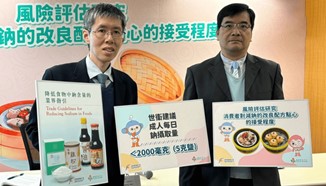
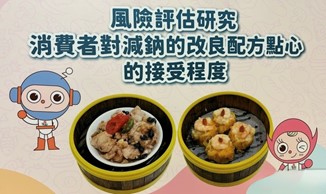
The CFS held a press briefing on 13 January for the publication of the report on the study
results on consumer acceptance of reformulated dim sum with reduced sodium. The results indicate that consumers accept a 10 to 20 per cent reduction of the sodium content in dim sum, suggesting that reducing the sodium content in dim sum is feasible for the industry.
For more information, please visit:
https://www.cfs.gov.hk/english/press/20250113_11391.html

2. The 88th Meeting of the Trade Consultation Forum
The 88th meeting of the Trade Consultation Forum was held on 27 March 2025. The CFS and the trade exchanged their views on topics including “Risk assessment study on microbiological quality of packaged rice balls”, “Risk assessment study on consumer acceptance of reformulated dim sum for sodium reduction”, “Proposal on regulation of konjac-containing jelly confectionery”, and “Advance release arrangement for Hong Kong-manufactured food products entering the Mainland market”. For details of the event, please visit:
https://www.cfs.gov.hk/english/committee/Notes_and_Presentation_Materials_TCF88_20250312.html


3. Promotion of the Habit of Eating Adequate Fruit by CFS and the Department of Health (DH)
The CFS has always supported the “Joyful Fruit Month” initiated by the DH. The campaign aims to promote the habit of eating adequate fruit every day and has received widespread support from schools and various sectors of the community over the years.

In April this year, the CFS even put up community posters with the theme of “Joyful Fruit Month” in public markets under the Food and Environmental Hygiene Department (FEHD) to continue to create a cheerful atmosphere and disseminate health messages.
4.Safe Food for All: To Understand Five Keys to Food Safety - Advice for Food Safety at Home” Talk 2025
The CFS is organising the 2025 Public Talks and Workshops on “Safe Food for All: To Understand Five Keys to Food Safety - Food Safety Advice at Home” from May to September this year. The programme aims to promote among the public the application of the "Five Keys to Food Safety" in daily life, with a view to preventing most food-borne diseases. Information about nutrition labelling and food allergy will also be provided.
For enquiries, please contact the Communication Resource Unit at 2381 6096.

Ask Our Mascots
Keeping raw meat away
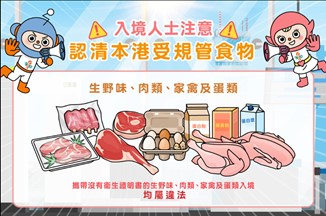
It is common for people to bring souvenirs back to Hong Kong after travelling, but unfortunately, some “new faces” are not so welcome at customs! Our mascots would like to remind you not to bring regulated food such as raw meat, game, poultry and eggs into Hong Kong illegally!
What's more, foods that merely have the packaging designs and materials changed (such as those packed in foil or vacuum packaging) are still subject to the regulations.
When bringing food into Hong Kong, remember to comply with the requirements of the relevant local laws!
Food Safety Quiz
1. Which of the following food should not be stored in the freezer?
- Fish
- Chicken
- Shell Eggs
- Steak
2. Which plants are the sources of the protein usually found in plant-based meat?
- Soy, peas and wheat
- Beef, chicken and pork
- Fish, eggs and dairy products
- Vegetables, fruits, and grains
3. Which of the following foods shall be accompanied by a health certificate or a permission in writing when being brought into Hong Kong under the Imported Game, Meat, Poultry and Eggs Regulations (Cap.132AK)?
- Cooked food and fruits
- Raw meat, game, poultry and eggs
- Canned food and dried products
- Beverages and snacks
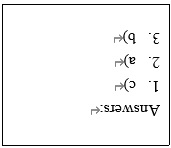
Diary of Mascot ON
1. Do Not Eat Raw Freshwater Fish
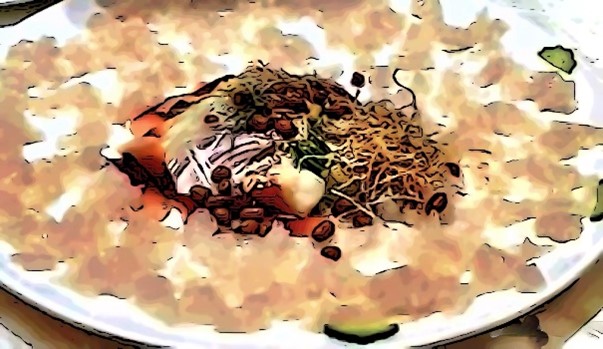
Freshwater fish raised in general environment (e.g. grass carp and big head carp) may carry, in addition to pathogens, parasites such as Chinese liver fluke (Clonorchis sinensis), which can cause obstruction of the bile duct, liver cirrhosis and cholangiocarcinoma. Wine, vinegar, wasabi, mustard and spices cannot destroy parasites including Chinese liver fluke.
Consumers are advised not to eat raw or undercooked freshwater fish in Hong Kong or when travelling abroad. Freshwater fish must be thoroughly cooked before consumption when having hot pot or congee. In order to protect public health, the sale of Chinese Yu Sang is prohibited in Hong Kong under the Food Business Regulation (Cap. 132X) .
Extended Reading:
Food Safety Focus - Clonorchis sinensis in Raw Freshwater Fish
https://www.cfs.gov.hk/english/multimedia/multimedia_pub/multimedia_pub_fsf_52_01.html

2. Microbiological Risks in Frozen Confections
With summer in full swing, ice cream, ice lollies, soft ice cream and other frozen confections are popular food for combating the intense heat. However, one must take proper precautions as improperly produced or stored frozen confections are conducive to microbiological growth (e.g. pathogens like Salmonella species, E. coli, Listeria monocytogenesNote 1) due to the abundance of nutrients and high temperatures.
Consumers should purchase frozen confections only from reputable vendors and keep them out of dangerous temperatures (i.e. 4°C or above) as much as possible to prevent bacterial growth, as re-freezing cannot eliminate the bacteria present. Keeping ice cream frozen during transit can also maintain its quality, as air bubbles in the ice cream which contribute to the soft texture will dissipate while melting. Therefore, ice cream will become firm after re-freezing at home. Consumers should use chiller bags and ice packs to carry frozen confections home and store them in the freezer as soon as possible.
For soft ice cream, poor hygiene and inadequate cleaning of the dispensing machines can lead to the growth of bacteria like Listeria and coliforms. Pregnant women should avoid consuming soft ice cream to prevent miscarriages caused by listeriosis.
Note 1: For information on pathogens, please visit the following website or scan the relevant QR code:
https://www.cfs.gov.hk/english/multimedia/multimedia_pub/multimedia_pub_fsf_24_02.html
